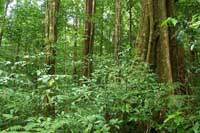A tree falls in the forest, found 380 million years later
The tree stood tall and spindly in the hot sun some 380 million years ago when something toppled it, maybe a storm or an earthquake.

It fell into water and dammed up in a muddy delta. The mud and sand on top hardened into sedimentary rock, hiding the fossilized tree for eons - until Frank Mannolini came by with a hammer and chisel.
Over the last three years, Mannolini and his fellow New York State Museum fossil hunter Linda VanAller Hernick painstakingly uncovered and curated the tree crown and a separate trunk specimen found in a remote rock quarry in upstate New York.
Their efforts were rewarded with an article in the April 19 issue of the weekly journal Nature describing their finds as significant examples of the oldest known tree: Wattieza. The chipped-away pieces are kept in the museum's storerooms. A portion of a 28-foot (8.5-meter) trunk impression, put back together like a jigsaw, lies on a floor.
"It took a lot of glue to put it back together," Mannolini said, looking over his work, "a lot of patience."
The trees were found about a half-hour southwest of Albany, in an area that has been on the paleontological map since 1870, when workers at a separate quarry stumbled upon a group of fossilized stumps. Shaped like big fat stone pears, the finds were dubbed the "Gilboa stumps" after the little town nearby.
The stumps had been cited as evidence of the world's oldest forest, but they provided only partial information about the ancient trees. It was like finding just a dinosaur leg. Scientists could make only educated guesses about what the rest of the tree looked like until Hernick and Mannolini uncovered the specimens.
It was especially meaningful work for both of them.
Hernick, the museum's paleontology collection manager, had been fascinated by the Gilboa stumps since seeing them on display as a girl.
Mannolini's connection to the site is stranger and sadder. His younger sister, Sharon Mannolini, was the museum's paleontology collection manager when she was killed four years ago in a car accident at age 35.
Brother and sister were fascinated by geology growing up. He would even bring his sister rocks he found when he went exploring in the woods.
He found out after her death that she had kept them her whole life.
Mannolini landed a temporary job at the state museum and eventually earned the same position his sister held. He now has his sister's old desk, and Sharon's picture stares out at him when he works there.
When he went to the quarry in 2004, he decided to start digging where his sister dug.
That's when he found a fossil of a tree's crown. The tree had branches fanning out at the top, making it look like a long-handled brush. Its profile slightly resembles a palm tree, but Wattieza had no leaves. It reproduced through spores.
"It's a look at the way the first trees were constructed," Hernick said.
The 28-foot-long section of a trunk was found in the summer of 2005. Scientific analyses on the finds were performed by state paleontologist Ed Landing, William Stein of Binghamton University and Christopher Berry of Cardiff University. They shared credit with the pair for the article in Nature, which said the specimens provide new insight into Earth's earliest trees and forests.
Wattieza grew probably as high as 30 feet (9 meters) in a world yet to see flowers, reptiles or dinosaurs. But the broken branches likely helped provide a hospitable habitat for centipede-like arthropods.
In the Devonian period, the land mass was on the latitude of Chile and warm. Now it's at a colder upstate New York latitude and Hernick and Mannolini do their digging in the summer. They are headed back this year.
"There are other kinds of trees up there, we think," Hernick said. They also will be on the lookout for different types of plant and arthropod fossils.
Mannolini is bringing a new chisel.
Subscribe to Pravda.Ru Telegram channel, Facebook, RSS!





